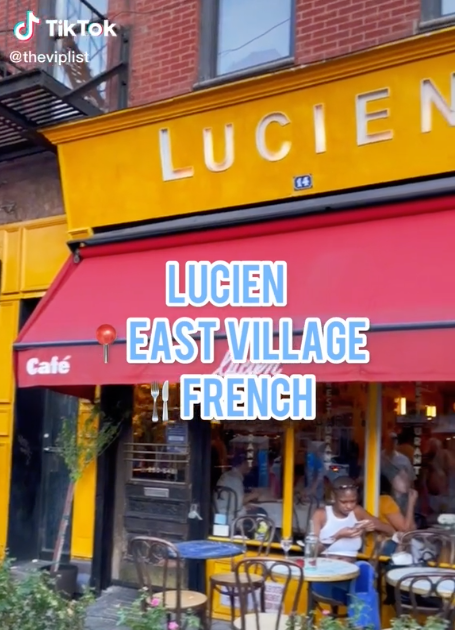#nyc #adayinmylife

Screenshot from “Restaurant Reviews: Lucien” video by @theviplist
Earlier this year I was obsessed with watching movies set in New York: campy comedies like Martin Scorsese’s After Hours felt like a night out when I was still hiding at home; erotic thrillers like A Perfect Murder and Dressed to Kill made the city seem more enticingly dangerous than it was during lockdown. As New York reopened, I stopped watching movies and started going out. Dining at restaurants, once a luxury, felt like a necessity—a way of re-entering the fantasy world of New York that I had streamed over the past year. It didn’t matter where I was going or who I was dining with. I just wanted to be out and around people, to feel like a main character living in New York City.
I’m not the only one who’s been going out more, at least according to TikTok. On my feed, iPhones pan across crowded New York City restaurants and plates loaded with steaks and pastas and gooey sauces, while raspy voice-overs celebrate or bemoan the food. These videos are more than restaurant reviews, they’re a sales pitch for the city—a reminder to whoever is watching that New York is back, and there’s no better way to celebrate than by spending money.
Like any other form of cultural mythmaking, TikTok generates desire for new experiences, shaping the way we navigate cities—and determining who gets to enjoy them. In the late eighties, the romantic blockbuster When Harry Met Sally functioned in part as a postcard for tourists and would-be New Yorkers curious about whether the infamous crime rates in Manhattan were beginning to decline. Harry and Sally, two University of Chicago graduates who move to the Empire State to pursue their careers—one becomes a journalist, the other a political consultant—experience the city as a land of promise, a place where good jobs and big apartments (and true love) present themselves to those willing and able to show up.
“A day in the life” videos on TikTok follow a similar narrative structure, showcasing the idealized lifestyles of college freshmen and entry-level marketers, most of them young white women, while they document their transition to NYC. Montages of neatly decorated studio apartments, strolls through Soho, and skyline vistas are punctuated by party scenes in rooftop lounges or laser-lit clubs. These videos provide an on-ramp to gentrification postlockdown, not unlike what When Harry Met Sally’s charming vignettes of Rockefeller Center, Macy’s, and now-iconic restaurants like Katz’s Delicatessen did for Mayor Giuliani’s “revitalization” of New York in the nineties. The majority of today’s New York–centric social posts are consumed by newcomers unbothered by unemployment rates or eviction moratoriums. Strung together in the feed, they generate a map for the young and upwardly mobile, whose idea of settling in the city isn’t finding or giving back to a community so much as engaging in commercial activities: spending money at bars and restaurants and boutiques to feel like they belong.
@katebartlettlife is good can’t complain  ##fashionstudent ##fashionschool ##nyc ##newyork ##dayinmylife ##dayinthelife ##fashioninstituteoftechnology♬ Call me – 90sFlav ##fashionstudent ##fashionschool ##nyc ##newyork ##dayinmylife ##dayinthelife ##fashioninstituteoftechnology♬ Call me – 90sFlav
|
@court0o0it was a chaotic day, gonna try again tomorrow ##homeless ##realliferecovery ##recovery ##SamsClubScanAndGo ##sober ##sobertok ##nyc ##harlem ##brooklyn ##fyp♬ Life Goes On – Oliver Tree |
Of course, not all TikToks are made for or by privileged transplants. Some document rat infestations and street confrontations, and satirize the dreamy vignettes that glamorize moving to the city with views of garbage-filled courtyards. But these grittier NYC-Toks still mostly frame the hardships of city life as part of its quirky charm—moments when, as one user puts it, “New York is New York–ing.”
There are sobering exceptions, like an unflashy segment titled “a day in my life as a homeless recovering addict in nyc,” but they’re not easy to find, as TikTok moderators are instructed to suppress or filter out posts by those deemed too ugly (i.e., insufficiently young and white) or too poor. That’s why you’re more likely to see a video of Andrew Yang bumbling his way through a visit to a Midtown deli in an effort to prove himself a “real” New Yorker than a clip from the perspective of a deli worker.
@notfromdenmark Stop dreaming, start doing Stop dreaming, start doing #nyc #nycapartment #nycstudio #apartmenttour #manhattan♬ Runaway – AURORA #nyc #nycapartment #nycstudio #apartmenttour #manhattan♬ Runaway – AURORA
|
@wincxclubsuch an eventful day ##nyc ##viral ##fyp ##minigolf ##avocado ##halloween♬ Squid Game – Carrot |
Those of us who use TikTok understand how the algorithm works—we have to strategize to ensure our place in the feed. And it’s so much easier to share experiences that play well in our online bubbles than to start putting roots down in our communities; we repeat the tropes we grew up seeing on Friends (set in New York but filmed in Los Angeles), romanticizing subway rides or trips to the deli. These fantastical and falsified narratives never capture what it feels like to really belong in a city. At least, I imagine they don’t. For now, like most NYC transplants, I’m still trying to play make-believe.
Taylore Scarabelli is a New York–based writer, consultant, and cofounder of Relevant Community. Her work has been published in New York Magazine, Artforum, Kaleidoscope, Spike, Vestoj, and more.
Copyright
© The Paris Review
